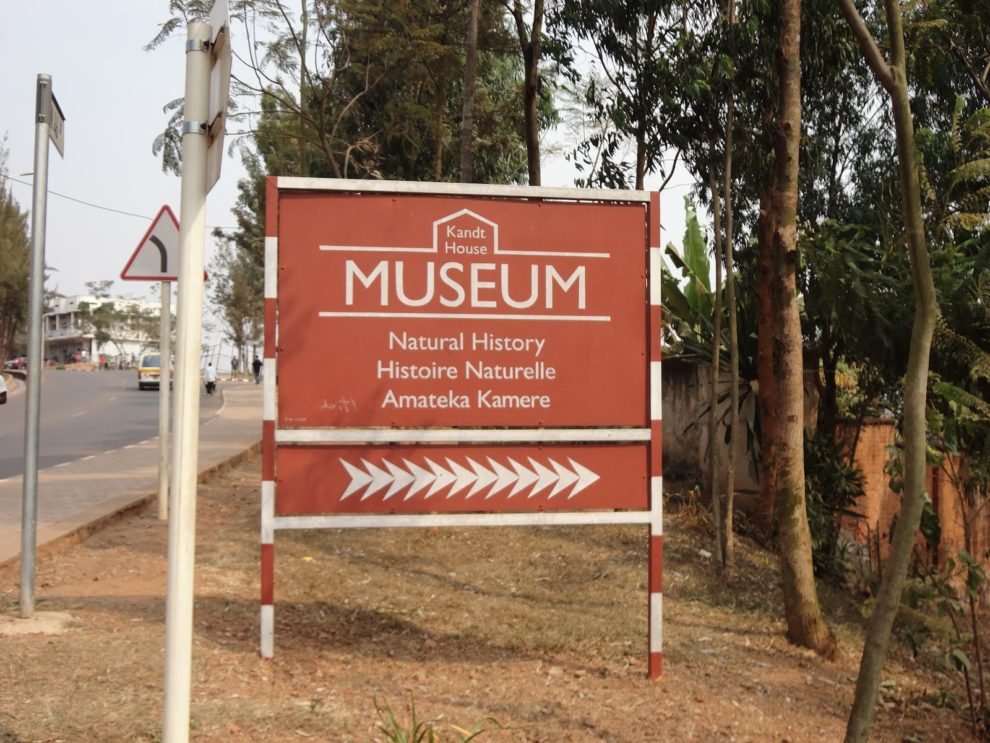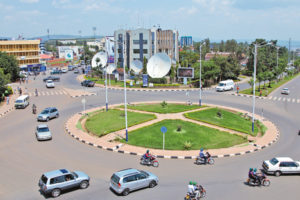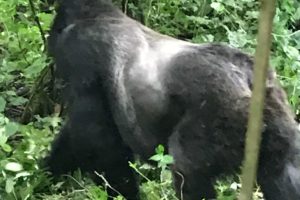Planning to visit Kigali, Rwanda and interested in cultural trips there are so many art and craft museum to visit. Therefore among them to visit include:
Kandt is a museum in Kigali, and it is under the responsibility of the Institute of National Museums of Rwanda. This was before a home to a German resident ‘’Richard Kandt’’ on the Nyarugenge Hill in Kigali city, which now was turned into a Natural History Museum since 2006. Richard Kandt was the first colonial governor of Rwanda, on behalf of Germany, until the early 1900s.The museum strives to show the evolution of life, description of Flora and Fauna of Rwandan Natural Parks (Nyungwe, Akagera and Volcanoes), geological background of Rwanda, German and Rwanda shared history and exhibition of live reptiles (snakes) with the aim to explain the interrelation between nature and history as a result of natural history museum. It is also the best view of three mountains (Mt Kigali, Mt Jali and Mt Shyorongi) and best view of old Kigali city.
Campaign against Genocide Museum
The museum was inaugurated by Rwanda’s President, Paul Kagame, in December 2017, making it one of the newest National Museums in Rwanda. It is located at the Parliamentary building in Rwanda’s capital, Kigali. This museum tells part of the many Rwanda’s sad stories of the yesteryears, of despair, struggling to free a people from the yoke of subjugation, the efforts and the sacrifices that were suffered and written during the time of rescuing the Tutsi from the strangling hands of Interahamwe – the campaign that was started from the parliament buildings and became a success.
While visiting Kigali and combine your wildlife and primate Rwanda tours with culture the museums are such fascinating things just like touring any other attractions. At the entrance of this museum, you will be welcomed by a traditional set up such as non-selective hospitality, Rwandan traditional home, Inyambo cows, cattle herdsmen, traditional weapons and fighters, girls and boys dancing among others. It has the internal and external wings according to Medard Bashana, the museum’s manager. The advantage of this museum is that it is located in the City of Kigali, just a 10 minutes’ drive from the Genocide Memorial of Gisozi and the International Airport of Kanombe and still within a walking distance from the Kigali Convention Center.
Presidential Palace Museum
This is a former presidential palace situated on the eastern outskirts of Kigali city and it has few exhibits, but it is surely interesting to explore, with ‘secret’ rooms and an odd presidential nightclub. Wreckage from Juvenal Habyarimana’s presidential plane can still be seen where it was shot down – just over his garden wall. The perpetrators were never caught but this act proved to be a rallying call for Hutu extremists and helped trigger the genocide. The Presidential Palace Museum is one of the new museums in Kigali, and it offers visitors a chance to visit the former state house as well as gain an overview of Rwanda’s history – one can also visit some of the flight debris of the FALCON 50 presidential plane that went down on 6th April 1994.
This former Presidential Palace Museum changed into Rwanda Art Museum effective from 18th May 2018. The new museum displays contemporary artworks produced by both Rwandan and international artists. The aim is to offer visitors’ insight into the originality of Rwandan creativity, arts development from centuries up-to-date, whilst not overlooking traditional or modern imaginations.
Apart from permanent exhibition, The Rwanda Art Museum hosts temporally and moving arts exhibitions as well. Young visitors also enjoy the Art Kids’ Studio where they are given the opportunity to put their art skills to work. The museum’s aim is to be a place where artists meet and exchange ideas. In this line, a room for them to exhibit their artworks has been provided by the INMR to their Federation.
Ethnographic Museum
The Ethnographic Museum, formerly the ‘’National Museum of Rwanda’’, is the national museum of Rwanda, located in Huye, about 132 kilometers south of Kigali. The Ethnographic Museum is one of the six museums that make up the Institute of National Museums of Rwanda. It was built with the help of the Belgian government – it first opened in 1989 and it is a good source of information on the cultural history of the country and the region.
It is also known as the site of the murder of Queen Dowager Rosalie Gicanda and several others during the Rwandan Genocide. The Ethnographic Museum now houses one of Africa’s finest ethnographic collections. Seven galleries display historical, ethnographic, artistic and archaeological artifacts accompanied by Visual Aides, thus providing visitors a rich insight into the Rwandan culture.
King’s Palace Museum
Nesled in Nyanza, 88 kilometers south of Kigali city, this was the residence of King Mutara III Rudahigwa and the Royal Palace that was traditionally built. This Palace offers a detailed look into Rwandan traditional seat of their monarchy, it is an impressive museum, restored to its 19th century state and made entirely with traditional materials. On the neighboring hill of Mwima, one can also visit the burial grounds of King Mutara III and his wife Queen Rosalie Gicanda.
A reconstruction of the traditional royal residence, the King’s Palace is a fantastically-crafted thatched dwelling shaped like a beehive. In olden times, Nyanza was the heart of Rwanda. According to oral tradition, it was the site of battles and power struggles. For a long time, the monarchy was mobile, moving the court between various locations. When it eventually settled in one place, Nyanza was the obvious choice. The capital of the kingdom had as many as 2,000 inhabitants, and huts built with the same methods. At the back, live a few long-horned Inyambo cattle, descended from the king’s herd, whose keepers carefully tend and sing to them, keeping alive a unique tradition.
The elegant cows, derived from the wider Ankole breed, played an important role during ceremonies in honor of the king. They were decorated with rich jewellery, and were taught to listen to a trainer’s songs and follow his movements in a stately parade. Rwanda ceased to be a monarchy in 1962, when it gained independence from colonial rule. However, the breeding and grooming of Inyambo is still carried out under the Rwanda Agriculture Board.
National Art Gallery Museum
Situated in Nyanza district, about 85 kilometers away from Kigali city, this museum displays contemporary Rwandan artwork which testifies to the originality of Rwandan creativity while not overlooking either tradition or national history. The museum was originally built as a Palace for King Mutara III Rudahigwa but he passed away before occupying it.
Rwanda’s most prestigious art museum is housed inside what was meant to be King Mutara III Rudahigwa’s new palace (he died before the building was completed in somewhat mysterious circumstances after a routine vaccination went wrong). Nowadays it houses mostly contemporary paintings and stylistic sculptures on themes dealing with the genocide, unity and brotherhood. Keep hold of your ticket, as admission to this museum entitles you to a 30% discount at King’s Palace Museum, which is just within a walking distance.
The building, designed by Belgian architect Robert Quintet, has been constructed at the end of the 1950’s. It is beautifully located on top of Rwesero hill. The building and location itself can be experienced as an excellent typical Rwandese attraction, as a masterly mixture of landscape, colonial architecture and royal history. It turned out to be a lucky shot to change the destiny of the palace into a museum. But even more important is its location in the city of Nyanza, were in former ‘royal’ days Rwandan culture was flourishing.
Inema Arts Centre
Located in the heart of Kigali city, Inema Art Center is one of East African’s major art galleries, housing a collection of artists from around the African Continent. Today, Inema Arts Center has become a beacon in Rwanda for cultivating creative expression. Inema Arts Center is a collective of Rwandan creative artists. At its core, Inema Arts Center provides space for 10 artists in residence to explore their creative talent.
Specializing in contemporary African Arts, Crafts, Music, and Dance, Inema’s artists produce paintings, sculptures, and mixed media expressions showcased in, the Gallery at Inema Arts Center. The Center is home to programs, projects, and initiatives that expand creative arts in Rwanda. Through workshops, trainings, and hands-on classes, the Inema Arts Center provides a space to fuel creative expression.
The Inema Gallery is the heart of Inema Art Center. It hosts a permanent show for the ten artists in residence with new paintings hung every day. Visit the Inema Studio to see artists painting and producing live. The centre showcases artists from around the world. Recent shows include; American, Belgian, and Moroccan painting and sculpture. The Gallery is a dynamic space and frequently fills for poetry nights, workshops, or cultural evenings. It is a home away from home for many organizations and always welcomes new ideas for how to use its space.





Add Comment